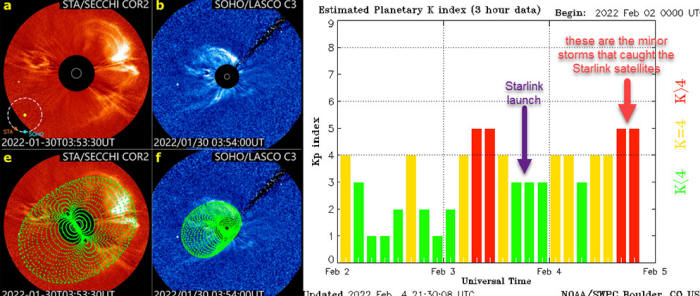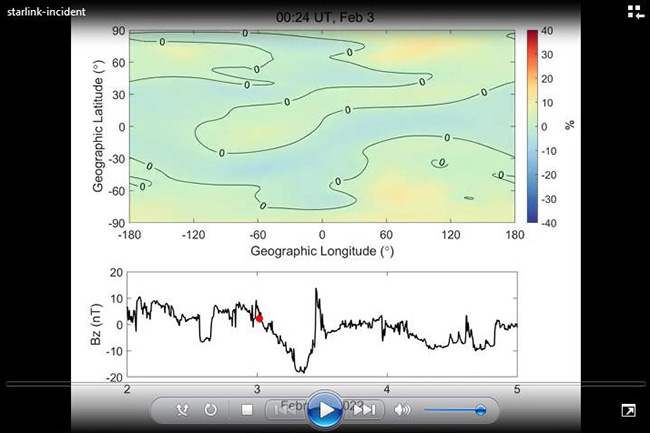|

by Dr. Tony
Phillips
September 13, 2022
from
SpaceWeatherArchive Website

Above: A Starlink satellite breaks up
over
Puerto Rico on Feb. 7, 2022.
Credit:
The Sociedad de Astronomia del Caribe
A minor geomagnetic storm
is supposed to be minor.
That's why even
experts were surprised on Feb. 4, 2022, when dozens of
Starlink
satellites started falling out of the sky...
A weak
CME had hit
Earth's magnetic field, and the resulting G1-class (minor) storm was
bringing them down.
How could this happen?
A
new paper published in
the research journal Space Weather provides the answer.
"Although it was only
'minor,' the storm pumped almost 1200 gigawatts of energy into
Earth's atmosphere," explains lead author Tong Dang of
the University of Science and Technology of China.
"This extra energy
heated Earth's upper atmosphere and sharply increased
aerodynamic drag on the satellites."
SpaceX launched the
satellites from Cape Canaveral on Feb. 3, 2022.
Forty-nine (49)
Starlinks were crowded inside the Falcon 9 rocket; less than a
quarter would survive.

Left: An Earth-directed CME implicated in the Starlink Incident.
Right: Geomagnetic indices showing how two minor geomagnetic storms
sandwiched the launch of the Starlink satellites.
As was SpaceX's practice at the time, the satellites were deployed
at an altitude of 210 km - their first stop en route to an
operational altitude near 600 km.
In the satellite
business, 210 km is considered to be low, barely above the
atmosphere. SpaceX starts there in case any satellite malfunctions
after launch. From 210 km, a "bad sat" can be easily de-orbited.
A little too easily, as it turns out.
Using a physics-based computer model named "TIEGCM," Dang and
colleagues simulated conditions during the storm. As geomagnetic
energy heated Earth's atmosphere, the air density at 210 km
increased globally by 20% with "hot spots" as high as 60%.
This movie shows what
happened:

Starlink dodged the worst spots.
"The satellites did
not hit any of the 60% regions," says Dang. "But that didn't
save them."
The weaker 20%
enhancements were enough to bring down 38 out of 49 satellites.
To prevent a repeat, SpaceX has started launching to 320 km instead
of 210 km. Earth's atmosphere has to reach that much higher to drag
the satellites back during a geomagnetic storm.
Since the change, more
than 1200 additional Starlink satellites have been launched on 24
rockets without incident.
There's still danger, though.
"Air density at 320
km is an order of magnitude less (compared to 210 km), but it's
not completely safe," cautions Dang's co-author Jiuhou Lei,
also from the University of Science and Technology of China.
"During an extreme
geomagnetic storm, density could increase from 200% to 800% even
at these higher altitudes."
Extreme storms may be in
the offing.
Young
Solar Cycle 25 is just getting
started.
The profusion of minor
storms we are observing today will intensify in the years ahead
especially as we approach Solar Max around 2025.
|




